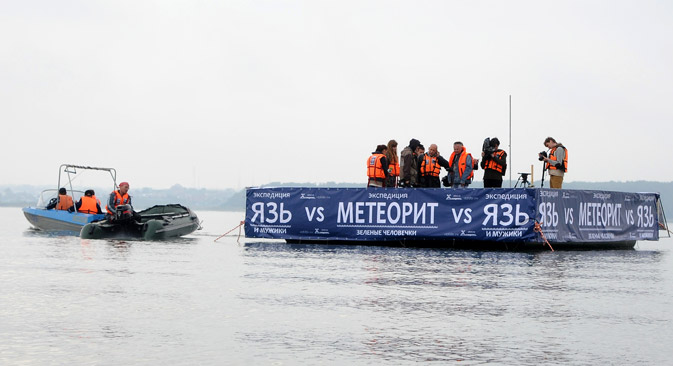
Divers are still searching for Chelyabinsk meteorite. Source: Alexander Kondratuk / RIA Novosti
Interesting events are unfolding at Chebarkul Lake near the area of the meteorite’s impact. Divers are still trying to search out the largest chunk of bolide. So far, they have only been able to reach it with a probe, and only smaller splinters have been found.
On the day of our visit, there was a cold drizzle over the lake and a bitter wind drove dark clouds across the sky. Leaving the shore, we made it to the location of the search mission in a rubber boat with a motor, which we shared with the Chelyabinsk lifeguards who remain on duty 24/7 back on shore.
The trip lasted less than 10 minutes and brought us to a platform with a surface area of about 20 feet by 26 feet, with a bright yellow tent at its center. This was the main “stationary” platform. Next to it were two more mobile platforms of smaller size, equipped with everything necessary for diving; the divers initiate dives from these platforms.
The platform offers a beautiful view of Chebarkul and its surroundings. Floating nearby is the famous 705-pound, red-and-white buoy that was placed there to mark the location of the meteorite’s landing. It has been moved about 77 yards to the side of the impact point, so as not to interfere with the search mission.
The pit at the bottom
In front of us, two divers enter the water, one after the other. In total, four people work on the brigade, plus the manager and his assistant. The most interesting things are happening underwater, though.
“You can call it a ‘pit’ […] being dug at the bottom of the reservoir with the help of special technical equipment,” Maxim Shipulin says, explaining the essence of the operation to us. He is the technical director at the Yekaterinburg-based company that is handling the meteorite’s lifting.
“At first, we thought that its diameter would be 20 feet, but it has reached 65 feet today and the scope of the search has expanded. Divers have passed the 45-foot mark. Work is being carried out in zero visibility conditions, by touch. This demands not only the highest level of professional training from the divers, but also an excellent vestibular system: You can easily lose your orientation in space,” says Shipulin.
“One of the team members was almost crushed by a dense layer of silt. It’s good he didn’t give in to panic. That is to say, there is an element of risk, and, the deeper divers go, the more difficult the work is,” the director says.
The team works from dawn to dusk, without days off. There is basically always someone underwater, with the exception of lunch break.
“Little green men” get in the way
According to divers, at the start of the operation, the hydrolocator indicated that “an object resembling a meteorite” was located at the bottom—but searches yielded absolutely no results. The mood changed after diver Alexei Lyakhov reached the meteorite with a 1.5-foot-long probe. Then, on Sept. 24, he found a chunk of the meteorite approximately the size of a fist.
Scientists collect over 100 kilos of Chelyabinsk meteorite pieces
“You get the feeling that some kind of ‘little green men’ don’t want to relinquish the cosmic body to earthlings,” Shipulin says, sharing his observations.
“We thought that we could reach the ‘big’ meteorite at a depth of 46 feet, but it keeps getting sucked deeper, and we are already talking about continuing the work at 52–65 feet. We have already come up with a new term — ‘intelligent sediment,’” says the technical director.
“In addition, unbelievable things are happening: We have punctured the boat five times, motors fail, and instruments go crazy. It’s just some sort of anomalous zone!”
We also visited the expedition’s tent camp, which is set up on the shore of Lake Chebarkul. The first thing that caught our eye was a banner: “The ide [fish] and men versus the meteorite and little green men.”
“There is that meme of a man who has just caught a big fish, smiles and yells, “Ide!’” says Nikolai Murzin, explaining the idea behind the banner. “We liked that image and decided to make it the symbol of this expedition. Well, everything else is clear about the men, about the meteorite and about the green men.”
Working in a secret zone
The team hauls up a mound of stones every day; they come across anchors and numerous magnets. With the help of these magnets, the meteorite hunters have tried to extract small pieces of the cosmic body.
As the expedition participants sort out so many rocks, they are beginning to identify them, working together with professional geologists: They say that meteorite fragments can be distinguished by melting properties and characteristic crystals.
After recovering three fragments at once on Sept. 26, they hope that they have finally come close to the “big” meteorite (according to preliminary data, it measures approximately 20 inches by 35 inches).
A meteorite fragment weighing 10.6 pounds was pulled up from the bottom by Maxim Gorbunov — the largest to date. The team did not permit us to take an historic photo, however: All work related to the meteorite must be done in secret. According to the terms of the contract, all information pertaining to the meteorite may only be released by the contracting client.
All rights reserved by Rossiyskaya Gazeta.
Subscribe
to our newsletter!
Get the week's best stories straight to your inbox